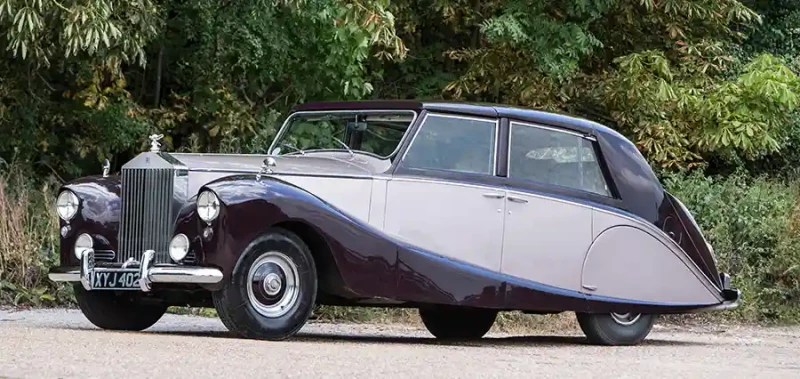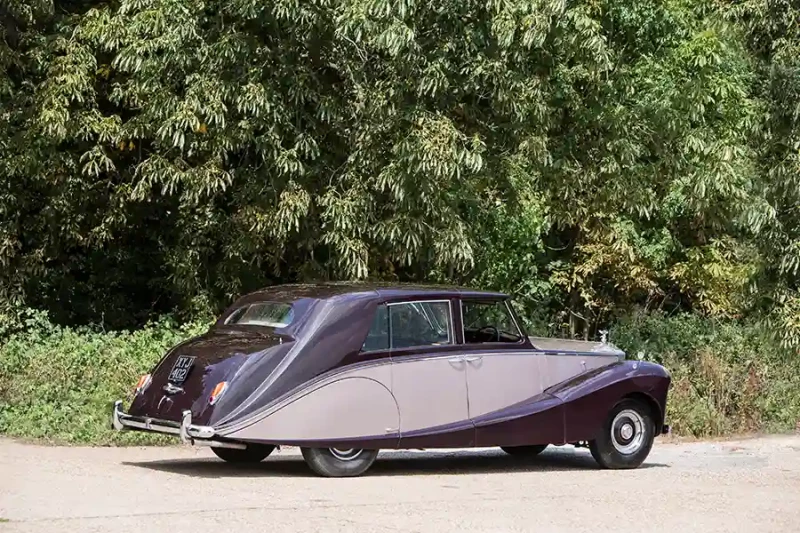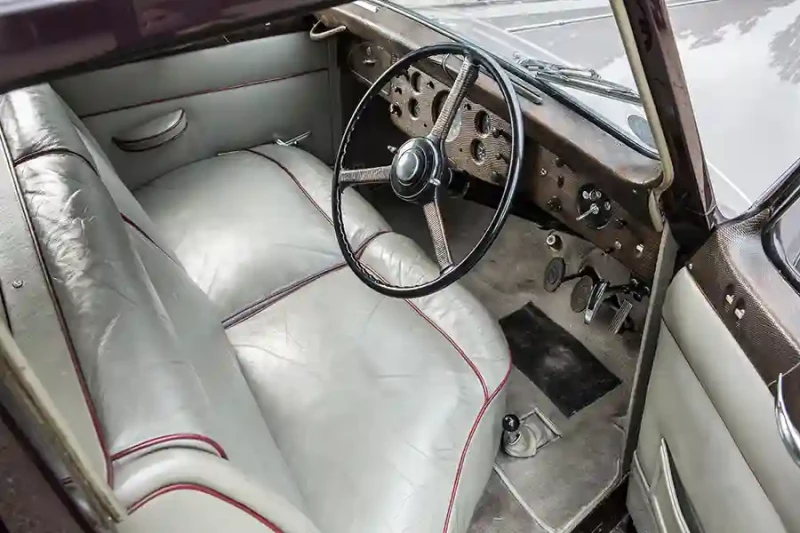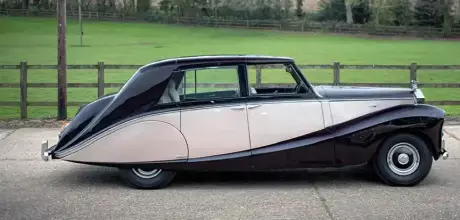1953 Rolls-Royce Silver Wraith Sedanca de Ville Coachwork by Hooper & Co
This is one of a few Rolls-Royces built for the oil millionaire Nubar Gulbenkian and probably the least outrageous, yet it was still enough of a head turner to find itself a movie role in a true cult classic.
WORD: NIGEL BOOTHMAN
PHOTOS: GREGORY OWAIN, KLAU-JOSEF ROSSFELDT
‘MOVIE’ SILVER WRAITH UNCLE MONTY’S CHOICE
“Though it’s sober and sensible compared with other Gulbenkian creations, it has extraordinary presence and a huge power to turn heads.”
GULBENKIAN’S SILVER WRAITH
Hooper one-off with a cult film history

You might think that with various highly personalised Rolls-Royces in his life, Nubar Gulbenkian would have cherished them above all other transport. But which of his cars is featured as a sketch on the back cover of his memoires? The dust jacket of Pantaraxia: An Autobiography (Hutchinson, 1965) depicts none of the above, but rather an Austin FX4 taxi modified by FLM Panelcraft with a brougham-style body, carriage lamps and wickerwork covering on the exterior panels. Perhaps he liked it for its silliness, perhaps because it was unique – after all, plenty of people had Rolls-Royces with eccentric coachwork – or perhaps because it was the most practical for London use. Gulbenkian’s famous remark on the car went thus: ‘It will turn on a sixpence – whatever that is.’ Nubar Gulbenkian was the son of ‘Mr Five Per Cent’. His father, Calouste Gulbenkian, was known for the extraordinary deal that guaranteed him 5% of the proceeds of Middle Eastern oil, back in the first days those fields were developed. Despite being born into vast wealth, Nubar wasn’t content with the life of an idle playboy and became a shrewd and successful businessman in his own right. He enjoyed his wealth quite publicly and played up to the image of an extravagant foreign potentate. His family was Armenian and though he divided his time between Paris, London and the South of France, he was educated at Harrow and Cambridge and regarded himself as British. He also held an Iranian passport, which came in handy during some cloak-and-dagger wartime adventures. After the war ended, Gulbenkian settled down in his flat near the Ritz with his third wife, and began to enjoy himself.

His first automotive project was the creation of a vast, rounded, semistreamlined body on a Rolls-Royce Silver Wraith chassis, built for him in 1947 by Hooper and viewed with some horror by Rolls-Royce – not least because he had discarded the traditional Palladian grille. For more on this car and Gulbenkian’s others, see the box-out. Gulbenkian was uncharacteristically humble about ‘Pantechnicon’, as it was called, admitting in his memoir that ‘I am sorry to say the effect I achieved, while certainly striking and distinctive, was not an unmitigated success’.
“I never feel totally dry unless I can seesomeone else who is totally wet”
STRIKING OUT AFRESH
By 1952 he had commissioned a dramatic four-door Silver Wraith tourer, also by Hooper, and very like chief designer Osmond Rivers’ ‘Docker’ Daimlers. Hooper’s ‘New Look’ coachwork aligned nicely with Gulbenkian’s taste and soon afterwards, he ordered the Silver Wraith you see here. The new car was delivered in August 1953, built to design 8359 – the only one made, as with all Gulbenkian’s cars. The body number was 9889 and the car wore the private plate NSG 2, for Nubar Sarkis Gulbenkian. The body style is, of course, a Sedanca de Ville, Gulbenkian’s somewhat outmoded preference. Few customers in 1950s Britain still felt that their chauffeur should be exposed to the elements. ‘I never feel totally dry unless I can see someone else who is totally wet,’ was Gulbenkian’s explanation!

His other personal touches were made in the interior. For some reasons, Gulbenkian didn’t like wood on dashboards or waist-rails – his cars were specified with alternative coverings. Here, we have reptilian hide. Hooper's original file on the car, saved by Osmond Rivers, contains patterns of 'lizard skin', so it is indeed from a species of lizard. Gulbenkian may have been a bit of a car nut, but he didn’t begin driving until he was 65. His cars, therefore, were made for him to enjoy from the back seat. Yet he still insisted on not only a clock but a speedometer mounted on the division, to ensure his man was making decent progress.
All of this is still just as Gulbenkian left it when we visit the car with its current owner, Anthony Kearsley.
Anthony acquired the car after the passing of the previous owner, his friend Rob Riding, a noted car collector based on the Isle of Man. Rob invested a vast sum reckoned at more than £185,000 in the restoration of this car with M.J. Pickles of Macclesfield, but the work has concentrated on the mechanical parts and the coachwork, leaving the interior delightfully original. Entering the ‘owner’s cabin’ is a thrill, the rear-hinged doors opening far enough for a gracious passage in and out, while the seats are as deep as an oil well – superbly comfortable, and perfect for a post-prandial snooze. The line of the C-pillar keeps a feeling of privacy without making it gloomy or claustrophobic in here, and there are reptile-skin ashtrays to catch the cigar stubs in the front of both armrests.
The silver lever below them reclines the seats… It’s a broad car, this – extra shoulder room in the cabins was one of the attractive features of OsmondRivers’ New Look designs. Wind up the electric division, wide and shallow like a Panavision cinema screen, and this quiet, soft, thoroughly pleasant space is perfectly isolated. But Gulbenkian’s crack about a soaking wet chauffeur is all for a laugh, really – the slide-out sedanca roof is extremely convincing and probably weather-tight.
Anthony shows me the process of bringing it out and back again, and it’s clearly a fine bit of engineering by Hooper. A T-handle unlocks the panel, the rear section of the roof lifts like a car bonnet and the sedanca panel slides forward on tracks. Down goes the rear section again and you have a conventional closed limousine. Life in the front, therefore, need not be damp and cold. There are electric windows in each door and the driving position is quite low; well out of the wind if the roof is back. The familiar right-hand change manual and equally unassisted steering makes the car something of a handful at parking speed, but once away, the smooth, quiet engine and docile nature of the Silver Wraith make it unthreatening to drive – you just have to remain aware of its size. Long after Gulbenkian’s ownership, this car found its way to Frank Dale & Stepsons and into the collection of James Crickmay. James is no longer with us, but his son Giles has plenty of memories of the car.
‘It was always around – I remember driving it up to the RREC annual rally one year and we used to use it quite a lot. It’s not that tricky or cumbersome and that Sedanca roof is ingenious. We also had Gulbenkian’s Perspex-top car for a while (see box-out – Ed) but I was nervous of driving that, with the irreplaceable roof, while this one was really useable and enjoyable. I’m very fond of it.’
UNCLE MONTY’S MOTOR
The Frank Dale dealer plate remains in the door jamb, and with an 01 London dialling code, dating it to 1990 or before. We think, as does Giles Crickmay, that the car was in his father’s ownership when it was used in the film Withnail & I in 1987. The film has become something of a legend, depicting the dissolute, chaotic life of two ‘resting’ actors in the bohemian London of the late 1960s, and their disastrous attempt at going on holiday to the Lake District. They are followed by Withnail’s eccentric, predatory Uncle Monty, another thespian but one with private means – and a Rolls- Royce. Monty drives the boys from the cottage in the fells to Penrith (acutally Stony Stratford, outside Milton Keynes) to buy pairs of wellington boots, but they spend the money on gin and cider before terrorising the tea rooms.
The Silver Wraith’s appearance only lasts a minute or so, but it does a wonderful job of marking the contrast between the scruffy, drunken actors and the flamboyant but superior Monty, who hisses ‘Get away from the car!’ when the two young men pile out of the rear compartment and stand waiting for their five-pound notes. Bruce Robinson’s film conjures up the street scenes of the late 1960s very well, partly because the cars are often scruffy; something other directors should remember when hiring concours classics to represent typical daily drivers of times past. This Silver Wraith would have been a splendid piece of fading glory, 15 years past its prime and distinctly outmoded by a changing culture. Very like poor Uncle Monty, then. Today, this car could serve a number of roles. Rob Riding’s restoration has left it in close to prize-winning condition and you could have an entertaining time presenting it at some of the more celebrated concours events. Then again, it still makes a useable, enjoyable family treat in which every picnic or trip to a car show becomes an event.
Though it’s sober and sensible compared with other Gulbenkian creations, it has extraordinary presence and a huge power to turn heads. Whether driving it or riding in it, it’s a mobile special occasion. We’ll leave the last word to Anthony Kearsley. He may well be familiar to readers as the owner of a large collection of Rolls-Royce and Bentley cars, many of which he operates through his business, Auto Couture.
He owns our cover cars from theprevious issue, too. This Silver Wraith is a car Anthony admired when Rob Riding owned it, and since Rob’s passing, it naturally means a lot to Anthony.
‘It’s a showstopper – as a car to arrive in, there’s nothing to touch it. Rob put so much into this car’s restoration because he admired it a great deal, and so do I, but I prefer not to drive it on narrow country lanes; Uncle Monty would never have got into the wilds of the Lake District in it! It’s a significant part of the fleet to me, but it could be available for sale. I think it’s beautiful and I want lots more people to see it.’ Hear, hear. Let’s hope this amazing machine is soon the centre of attention once again.
Sedanca's graceful tail echoes many coachbuilt Rolls-Royce and Bentley saloons of the era. Spare wheel swallows much room in the boot. Spotless engine bay is a tribute to huge recent spend.
A Gulbenkian quirk — he could keep an eye on the speed at all times. Division is electrically raised and lowered. The largest, comfiest armchairs you've ever tried.
Wide front seats can be treated as one bench Yes, even the steering-wheel spokes are bound in lizard skin Not much space between seat and wheel, but acres of shoulder room. Peculiar sun-blinds are stiff but effective.
Reptilian finish gives a dark, almost sinister look.
Down goes the rear section… and shuts with a click Anthony shows us the process of extending the roof Graceful spats are a vital feature of the styling
WEIRD OR WONDERFUL? – GULBENKIAN’S OTHER CARS
Nothing quite lived up to the ambition and daring of the first Gulbenkian Rolls-Royce, Silver Wraith chassis WTA62, named ‘Pantechnicon’. As Nubar himself put it: ‘Hitherto, motor-cars had been merely an adaption of the old horseless carriage; I felt that a modern car should be streamlined, curved and should look as though it had been designed by someone who had never seen horse-drawn carriages and had been presented for the very first time with the task of building a body around an internal combustion engine.’ Success or failure on that score is in the eye of the beholder, but after a few misadventures this amazing machine is now in private hands and nearing the end of an in-depth restoration. Let’s hope we see it again soon. Gulbenkian’s next adventure was the swoopy four-door Silver Wraith tourer on chassis ALW11, very close to Osmond Rivers’ designs for Sir Bernard and Lady Docker’s Daimlers, right down to the stacked headlamps behind curved Perspex screens. This car must have proved surplus to Gulbenkian’s requirements soon after, as it was in Nigeria by 1955 and was used to transport the Queen on her visit the year after. Meanwhile, Gulbenkian had commissioned another Silver Wraith, almost as dramatic as the Pantechnicon. This car, chassis LELW74, featured a Perspex roof on another swooping Osmond Rivers body and was supposedly built for the South of France, where all occupants would surely be roasted alive on sunny days. It wound up as a static exhibit in a nightclub before being repatriated and restored. The Austin FX4 taxi by Panelcraft mentioned at the start of this article had a sister vehicle, slightly less OTT, and there was one more Rolls-Royce, too. It’s not mentioned often, but its story is told on Klaus-Josef Rossfeldt’s excellent website, rrab.com. Silver Cloud II, chassis LCA39, was bodied in 1961 by FLM Panelcraft, yet again a Sedanca de Ville. The Gulbenkian features were all there: no wood on the dash, rear-hinged back doors and a spacious rear compartment with a speedometer and a clock. It survives and has recently been beautifully restored and returned to dark green over light green.



